|
The Gooseneck (Page 2)
This page was last updated on July 10, 2004. |
<Back to Page 1
To prepare for ordering the new gooseneck
hardware, I spent some time measuring up the boom and existing hardware,
making numerous sketches and photographing everything. I also
prepared full-size templates of my mast and boom, using a piece of
electrical solder to conform to the spars, after which I could easily
trace it out onto a piece of paper. Feeling prepared for
anything, I began some online research.
|
I soon latched on to the website at www.rigrite.com,
and, despite the amateur, poorly-constructed navigation and layout of
the site, managed to find my original boom section listed, with a
variety of hardware options. They didn't seem to have the ideal
solution for my gooseneck needs, though, so I browsed the site endlessly
on a Sunday, eventually finding a similar boom section that had myriad
accessories--including the gooseneck bracket and reef hook/tack hook
assembly that I wanted.
Excited with my finds, and thinking that
my problems would soon be solved, I laboriously prepared a list of
requested parts, as well as detailed drawings of my arrangement, and
faxed it off to Rig-Rite for a quote, as directed by the site.
After a couple days with no response, I
called the company to inquire. Yes they had received my fax.
Great, said I. When might I be able to expect a quotation?
"Oh,", said the unhelpful phone person, "they ought to be
able to look at it in about two weeks or so". Two
weeks? To get a quote on supposedly "stock" parts?
Attempts to get further information was like getting blood from a stone,
and I finally hung up with a vague (to be mild) promise from the bimbo
to see if maybe they could quote me on the complete order I had
prepared. Needless to say, as of this writing I am anything but
surprised to report that I have heard absolutely nothing from these
fools.
Moral of the story: forget
Rig-Rite.
This wasted about a week, and it was into
the next week before I had a chance to call my rigger for advice.
When I mentioned my experience with Rig-Rite, he barely contained a
disdainful chortle, and then, as tactfully as possible, told me what I
already knew: that they really don't have what they say they have;
and besides, they overcharge for what they do have. Anyway.
Moving on, he recommended I call
Metalmast Marine, in Connecticut, but warned that at that particular
time, they were heavily involved in finishing a mast project for a
client who was dying, but wanted to see the completed rig before he
passed--or some such. As a result, he recommended I wait a week
before calling, which advice I heeded.
Later, I phoned Metalmast, to be greeted
by the helpful--and quite French--Claude on the phone (I had been
forewarned). I described what I was looking for, and he eventually
gave me a list of measurements, etc., that he needed--which I promptly
provided by fax the next day, after returning to the boat to double
check a couple things.
This is where things began getting
interesting.
|
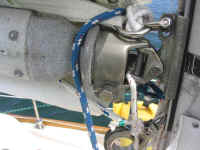 Claude
couldn't visualize my current arrangement--he kept insisting that I had to
have a vertical pin, and I soon came to realize that the setup I had was
somewhat unusual. Eventually, after several more faxed drawings, he
came to understand what I had. My boom features the old (abandoned)
roller reefing arrangement at the mast end, which is connected to the mast
through a toggle with horizontal pin that secures to a bronze car riding
on the mast T-track. Claude
couldn't visualize my current arrangement--he kept insisting that I had to
have a vertical pin, and I soon came to realize that the setup I had was
somewhat unusual. Eventually, after several more faxed drawings, he
came to understand what I had. My boom features the old (abandoned)
roller reefing arrangement at the mast end, which is connected to the mast
through a toggle with horizontal pin that secures to a bronze car riding
on the mast T-track.
Click here to see a series of measured
sketches of my boom and gooseneck arrangement.
|
He quoted me a couple prices for a gooseneck
bracket and custom toggle to fit my current boom end; the bracket was
reasonable, but the custom toggle would run twice as much as that.
It was at about this time that Claude carefully, tactfully started probing
for deeper answers to my situation, and what I was trying to
accomplish. Why, he asked, was I looking to spend all this money?
Thus began a discussion about my whole
sail, vang, and boom situation. We discussed the rigid boom vang,
and he asked if not my boom resembled a banana (in the way that only a
French person could)? I had to agree that yes, the boom did resemble
a banana sometimes, and that I was frequently harboring concerns myself
about the overall strength of the boom in light of my serious boom
vang. When I also mentioned that I had a loose-footed mainsail, he
became even more animated. Note that I never felt I was being
oversold in any way--he was just forcing me to address issues that I had
thought about many a time before. I give Claude high marks for tact,
and for never pushing to sell me any more equipment than I was willing to
consider.
Given that I had often wondered about my
boom, particularly after switching to a loose-foot in 2003, I decided to
move forward in the direction of a new boom, one that was engineered for
the stresses that my main and vang would put on it. Why skimp, after
all? I was sick of my boom and gooseneck problems, needed a better
tack/reefing hook setup anyway, and was more than tilling to discuss
something that would make the boat sail better, and more safely.
I had to return to the boat once more to
take a series of new measurements. Finally, after a week or more of
back and forth, fax problems on my end, and computer problems on Claude's
end, I had provided him with all the critical information he needed.
He gave me a quote for the following:
- New boom of the appropriate length and
properly engineered for the loads involved
- Custom gooseneck bracket for the mast,
to fit my mast profile
- Integral bracket to accept my boom vang
end, located as per my measurements
- New tack hook and two reefing hooks on
boom end
- Mainsheet bail at aft end of boom
- Internal outhaul rig
- No reefing lines; I decided I wanted to
maintain my current setup
- Winch pad
- Unpainted, non-anodized spar
I ordered the spar, with delivery estimated
at two weeks hence.
Could I have gotten away with something
less? Of course, probably. But why mess around at this
point? The new boom will cost more than I had hoped, but buying it
will not keep me from sailing, or mean that we have to starve for a month,
or any such thing. What the boat wants, the boat gets--that's pretty
much how it is in our household. I'm never one to skimp on important
gear--and what is more important on a sailboat, after all, than sails and
spars that work properly?
|
Given the timing of the order, and with a
pending cruise departure later in July, I wondered whether I would have
the new boom in time. I didn't want to depart with my gooseneck in
its current condition--it's definitely too weak, and my latest repair
(previous page), while still holding, was definitely starting to pull out
as before.
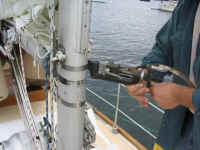 Earlier,
my friend Nathan had indicated he had a friend with a banding tool that he
had used to repair a reefing track on a 58 footer at sea one time, and
that he (Nathan) could probably borrow it if I felt it was necessary to
reinforce my gooseneck more. I decided that it was worth the effort
to band the T-track in place on the mast, and to reinforce the connection
against unwanted movement. This way, I felt that I could leave on my
cruise in good conscience, since it seemed increasingly unlikely that the
timing for delivery (or possible pickup myself) of the new boom would work
out to my advantage. Conversely, taking the time to band the track
on probably guaranteed that the new boom would be ready sooner than later
anyway! We met at the boat one afternoon to install the bands. Earlier,
my friend Nathan had indicated he had a friend with a banding tool that he
had used to repair a reefing track on a 58 footer at sea one time, and
that he (Nathan) could probably borrow it if I felt it was necessary to
reinforce my gooseneck more. I decided that it was worth the effort
to band the T-track in place on the mast, and to reinforce the connection
against unwanted movement. This way, I felt that I could leave on my
cruise in good conscience, since it seemed increasingly unlikely that the
timing for delivery (or possible pickup myself) of the new boom would work
out to my advantage. Conversely, taking the time to band the track
on probably guaranteed that the new boom would be ready sooner than later
anyway! We met at the boat one afternoon to install the bands.
|
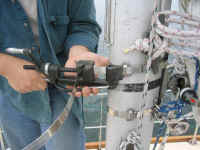 Once
we figured out the basics of the tool, it was really quite simple to
use. Nathan ended up doing the work, while I watched and held the
directions. Basically, the concept is that you wrap stainless steel
banding twice around the mast and pass it through a specific clamp.
Then, the manual banding tool is applied, which grips the band and
tightens it with a screw-device. Once tight, the tool includes a
cutter to clip the band, and the stainless steel buckle is hammered around
the band, securing the bitter end. Once
we figured out the basics of the tool, it was really quite simple to
use. Nathan ended up doing the work, while I watched and held the
directions. Basically, the concept is that you wrap stainless steel
banding twice around the mast and pass it through a specific clamp.
Then, the manual banding tool is applied, which grips the band and
tightens it with a screw-device. Once tight, the tool includes a
cutter to clip the band, and the stainless steel buckle is hammered around
the band, securing the bitter end.
|
It worked very well. We put the buckle
on the wrong way on our first try, so had to unwind the band and start
over. However, that was the only mistake, and, for two completed
bands, we only did the process three times total--pretty good for two
morons who had never used this tool before. The completed bands were
tight, and appeared to be the sort of temporary repair that could, under
different circumstances, become permanent. I felt good about the
repair, and if it ended up remaining on there until after our cruise, that
would be fine.
|
|
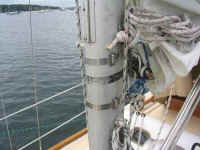
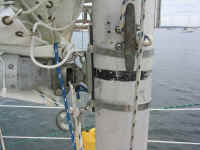
|
Please click here to
continue.>
|
|